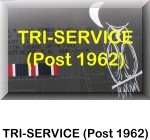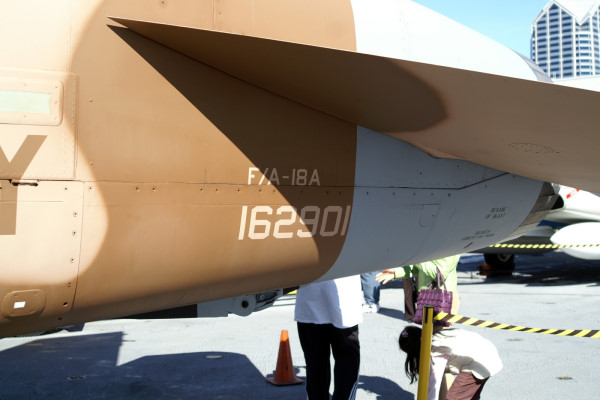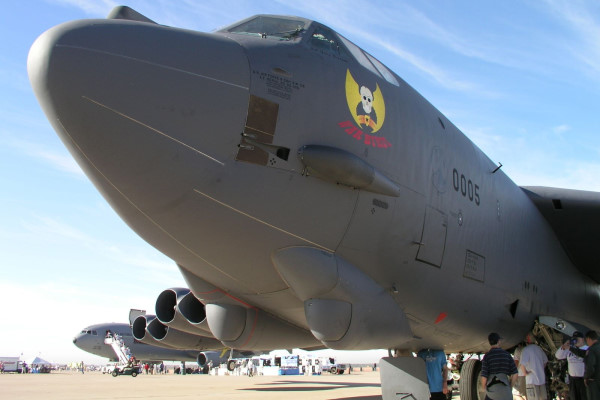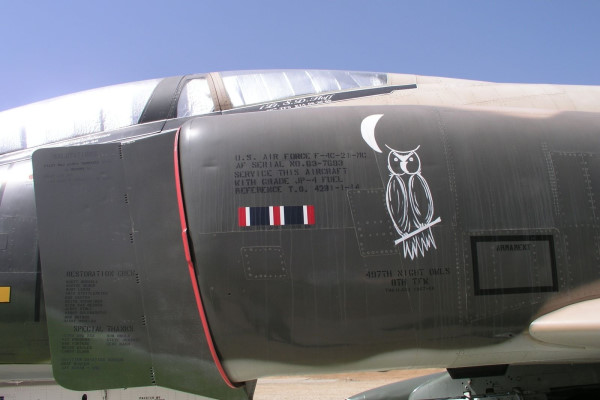
























United States Tri-Service Aircraft Designation System (Post 1962)



On the 18 September 1962, the United States Department of Defense introduced a unified designation system for the aircraft of the United States armed forces. Prior to this date, each service used their own nomenclature system. The 1962 system was based on the one used by the U.S. Air Force between 1948 and 1962. Since it was introduced the 1962 system has been modified and updated; in 1997 a revised form of the system was released. Almost all aircraft operated by the USAF, United States Navy (USN), United States Coast Guard (USCG) and United States Marine Corps (USMC)) and the United States Army are assigned a designation under this system. Experimental aircraft operated by manufacturers or National Aeronautics and Space Administration (NASA) are also often assigned numbers in the X-series.
The designation system produces an MDS (Mission-Design-Series) designation of the form:
Of these components, only the Design Number, Series Letter and Basic Mission are mandatory. In the case of "special" vehicles a Vehicle Type symbol must also be included. The options and usage of each designation elements is discussed below.
(1) Aircraft Status Prefix (Optional)
The status prefix indicates a nonstandard use of an aerospace vehicle, such as test, experimental, prototype, etc. Appears to the immediate left of the modified mission symbol or basic mission symbol for aircraft. Appears to the immediate left of the launch environment symbol or basic mission symbol for rockets and missiles. Example: YF-23A. Status prefix "Y" denotes an F-23A prototype.

Northrop YF-23A "Black Widow II"
"Y" Denotes "Prototype" Status
| Aircraft Status Prefix Symbols | ||
|---|---|---|
| G | Permanently grounded | Aircraft permanently grounded (may be used for ground training). |
| J | Special test, temporary | Aircraft in special test programs but authorized organizations, on bailment contract with a special test configuration, or with installed property temporarily removed to accommodate a test. |
| N | Aircraft in special test program but authorized that kiddies or on bailment contract where the configuration changes so drastically that returning to the original operational configuration is impractical or uneconomical. | |
| X | Experimental | Aircraft in a development or experimental stage. |
| Y | Prototype | A model suitable for evaluation of design, performance, and production potential. |
| Z | Planning | Aircraft in the planning or predevelopment stage. |
(2) Aircraft Modified Mission (Optional)
The modified mission symbol identifies modifications to the basic mission of an aircraft. Appears to the immediate left of the basic mission symbol. Example: KC-135E, Modified Mission "K" identifies a C-135E modified for "Tanker".

Boeing KC-135E "Stratotanker"
"K" Denotes "Tanker" Status
| Modified Mission Codes | ||
|---|---|---|
| A | Attack | Aircraft modified to find, attack, and destroy enemy targets using conventional or special weapons. The symbol also describes aircraft used for interdiction and close air support missions. |
| C | Transport | Aircraft modified to carry personnel, cargo, or both. |
| D | Director | Aircraft modified for controlling drone aircraft or missiles. |
| E | Aircraft modified with electronic devices for one or more of the following admissions:
| |
| F | Fighter | Aircraft modified to intercept and destroy other aircraft or missiles. |
| H | Search/Rescue/MEDEVAC | Aircraft modified for search and rescue and/or MEDEVAC missions. |
| K | Tanker | Aircraft modified to refuel other aircraft in flight. |
| L | Cold Weather | Aircraft modified for operation in Arctic in Antarctic regions. Includes skis, special insulation , and other equipment for extreme cold weather operations. |
| M | Multi-mission | Aircraft modified to perform several different missions. |
| O | Observation | Aircraft modified to observe (through visual or other means) and report technical information concerning composition and disposition of forces. |
| P | Patrol | Long Range, all weather, multiengine aircraft that operate from land or water bases modified for independent anti-submarine warfare, maritime reconnaissance, and mining. |
| Q | Drone | An aerospace vehicle modified for remote or automatic control. |
| R | Reconnaissance | Aircraft Then modified for photographic or electronic reconnaissance missions. |
| S | Antisubmarine | Aircraft modified to find, identify, attack, and destroy enemy submarines. |
| T | Trainer | Aircraft modified for training purposes. |
| U | Utility | Aircraft modified to perform multiple missions such as battlefield support, localized transport, and special light missions. |
| V | Staff | Aircraft modified to provide support for the President or Vice President of the United States. |
| W | Weather | Aircraft modified and equipped for meteorological missions. |
(3) Basic Mission (Required)
The basic mission identifies the primary function and capability of an aerospace vehicle and is the initial symbol assigned to that series. For standard vehicles (e.g., bombers, fighters), it appears to the immediate left of the design number separated by a dash. EXAMPLE: F-4B. Basic Mission "F" denotes fighter. For nonstandard vehicles it appears to the immediate left of the vehicle type symbol. EXAMPLE: LGM-118A. Vehicle Type "M" indicates guided missile; Basic Mission "G" indicates surface attack.

McDonnell Douglas F-4B "Phantom II"
"F" Denotes "Fighter" Status
| Basic Mission Codes | ||
|---|---|---|
| A | Attack | Aircraft designed to find, attack, and destroy enemy land or sea targets using conventional or special weapons the symbol also applies to aircraft used for interdiction and close air support missions. |
| B | Bomber | Aircraft designed for bombing enemy targets. |
| C | Transport | Aircraft designed primarily to carry personnel, cargo, or both. |
| E | Aircraft modified with electronic devices for one or more of the following admissions:
| |
| F | Fighter | Aircraft designed to intercept and destroy other aircraft or missiles. Includes multipurpose aircraft also designed for group support missions such as interdiction and close air support. |
| L | Laser | Vehicle designed for employing a high-energy laser weapon. |
| O | Observation | Aircraft designed to observe (through visual or other means) and report tactical information concerning composition and disposition of forces. |
| P | Maritime patrol | Long Range, all whether, multi-engine aircraft operating from land or water bases designed for independent anti-submarine warfare, maritime reconnaissance, and mining. |
| R | Reconnaissance | Aircraft designed for photographic or electronic reconnaissance missions. |
| S | Anti-submarine warfare | Aircraft designed to find, detect, identify, attack, and destroy enemy submarines. |
| T | Trainer | Aircraft designed for training purposes. |
| U | Utility | Aircraft designed to perform a multiple missions such as battlefield support, localized transport, and special light missions. Included are aircraft designed for small payloads. |
| X | Research | Aircraft designed for testing highly experimental configurations. These aircraft are not generally intended for use as operational aircraft. |
Of these code series, no normal aircraft have been assigned a K or R code in a manner conforming to the system. The rise of the multi-role fighter in the decades since the system was introduced has created some confusion about the difference between attack and fighter aircraft. According to this designation system, an attack aircraft is only capable of ground attack missions (e.g. the A-6 Intruder and A-10 Thunderbolt II), while a fighter need only possess minor air-to-air combat capabilities (e.g. the F-111 "Aardvark"). The Air Force prefers to refer to its attack aircraft as "fighter-bombers," thus the F-111 and F-117, which are purely attack aircraft. The only "Attack" aircraft in the USAF's current inventory is the A-10 Warthog.
(4) Vehicle Type (Nonstandard Vehicles Only - Required)
This is required for nonstandard vehicles, such as helicopter, vertical takeoff and landing (VTOL), UAV control segment, space, etc. A basic mission or modified mission symbol must accompany the vehicle type symbol. Vehicle type appears to the immediate left of the design number, separated by a dash. Example: CH-53E. Vehicle Type "H" indicates a helicopter with a Basic Mission of transport "C".

Sikorsky CH-53E "Super Stallion"
Vehicle Type "H" indicates a helicopter with a Basic Mission of transport "C"
| Vehicle Type Codes | ||
|---|---|---|
| D | Unmanned Aerial Vehicle Control Segments | Ground Control Segments for unmanned aerial vehicles (UAVs). |
| G | Glider | Fixed wing aircraft flown by using air currents to keep it aloft. |
| H | Helicopter | Rotary wing aircraft (deriving lift from a rotating lifting surface). |
| Q | Unmanned Aerial Vehicle (UAV) | An unmanned aircraft that uses aerodynamic forces for lift, autonomously or remotely piloted, expendable or recoverable, and carries a non-lethal payload. A version of a UAV that carries a lethal payload is called an Unmanned Combat Air Vehicle (UCAV). |
| S | Spaceplane | Aircraft designed to travel above the earth's atmosphere and returned to earth in support of space operations. |
| V | VTOL and STOL | Aircraft designed to take off and land vertically or in a very short distance. |
| Z | Lighter-Than-Air Vehicle | Non-rigid or semi-rigid aircraft that achieves its primary live to the use of hot gases or lighter-and-air gases (includes blimps and balloons). |
(5) Design Number (Required)
The design number identifies major design changes within the same basic mission. Design numbers run consecutively from "1" to "999" and appears to the immediate right of the basic mission or vehicle type symbols, separated by a dash. EXAMPLE: F/A-18A. Design Number "18" is the 18th MDS requested for an aircraft with a fighter mission under the current MDS reporting system, which was implemented September 1962.

McDonnell Douglas F/A-18A "Hornet"
Design Number "18" indicates the 18th "Fighter" designation
(6) Series Number (Required)
The series number identifies the production model of a particular design number and later models representing major modifications that significantly alter the aerospace vehicle systems components or change of logistics support of the vehicle. Consecutive series symbols, starting with "A", appear to the immediate right of the design number. To avoid confusion, the letters "I" and "O" are not used for this symbol. EXAMPLE: F/A-18E. Series "E" indicates the 5th production model of the F/A-18. At the end of this series indicator "Z", the next sequence will be to advance the design number to the next consecutive unused number and begin with symbol series "A".

Boeing F/A-18E "Super Hornet"
Series Number "E" indicates the 5th production model of the F/A-18
NOTE: The following descriptions for configuration, block, and serial numbers further identify configuration or specific vehicles, but are not part of an MDS designator. DOD 4120.15-L does not contain these numbers. Assignments of configuration, block, and serial numbers do not require coordination with HQ AFMC/LGSI or approval by HQ USAF/XP.
(7) Configuration or Component Number (Optional)
The configuration or component number denotes configuration changes that affect performance, tactics, or integral components of a weapon system that require the same operations or logistics reporting as the aerospace vehicle. Appears to the immediate right of the series symbol, separated by a dash. Each Military Department determines its own method of assigning configuration numbers.
(8) Block Number (Optional)
The block numbers are no longer a required part of the official MDS designation, and their use is optional to the various DOD services. Block Numbers are used for some production aircraft, but not all. Block numbers were introduced by the U.S. Army Air Force in World War II to distinguish between minor sub-variants of a specific aircraft variant. They were originally assigned in steps of five, i.e. 1, 5, 10, 15, ..., with the gaps being intended to be used for modifications after production. This was also the rule for block numbers as defined in the first issue of the current designation system in 1962. The current AFJI 16-401, however, defines block numbers as optional and doesn't state any rules for their actual application. In fact, there are several aircraft types where the block numbers were assigned in strict sequence from 1 up, leaving no gaps. It also seems that the USAF doesn't generally use the "dash-number" nomenclature any more, e.g. the latest B-2A update is generally referred to as "B-2A Block 30" and not "B-2A-30".

Boeing B-52H-135-BW "Stratofortress"
The Block Number is "135"
(9) Manufacturer Code Letters (Optional)
The original designation system as defined in 1962 also mandated the use of a two-letter code suffix to identify the manufacturing plant of an aircraft. Like the block numbers, these code letters were introduced by the USAAF during World War II. However, manufacturers' codes were officially dropped from the regulations in 1976. Therefore they are no longer mandatory, and even their optional use has apparently essentially ceased. The list of code letters as defined in 1962 follows:

McDonnell Douglas F-4C-21-MC "Phantom II"
The Manufacturer Code "MC" indicates that the Aircraft was built by McDonnell Aircraft Corp, St. Louis, MO
| 1962 Manufacturer Code Letters | |
|---|---|
| AE | Aeronca Aircraft Corp., Middletown, Ohio |
| BC | Bell Aerosystems Co., Buffalo, New York |
| BF | Bell Helicopter Corp., Forth Worth, Texas |
| BH | Beech Aircraft Corp., Wichita, Kansas |
| BN | Boeing Co., Renton, Washington |
| BO | Boeing Co., Seattle, Washington |
| BV | Boeing Co. (Vertol Division), Morton, Pennsylvania |
| BW | Boeing Co., Wichita, Kansas |
| CE | Cessna Aircraft Co., Wichita, Kansas |
| CF | Convair, Forth Worth, Texas |
| CO | Convair, San Diego, California |
| CV | Chance Vought Aircraft, Dallas, Texas (changed from VO) |
| DH | DeHavilland Aircraft of Canada, Toronto, Canada |
| DL | Douglas Aircraft Co., Inc., Long Beach, California |
| DM | Doman Helicopter, Inc., Danbury, Connecticut |
| DO | Douglas Aircraft Co., Inc., Santa Monica, California |
| DT | Douglas Aircraft Co., Inc., Tulsa, Oklahoma |
| FA | Fairchild Aircraft Division, Hagerstown, Maryland |
| GO | Goodyear Aircraft Co., Akron, Ohio |
| GR | Grumman Aircraft Corp., Bethpage, New York |
| GT | Grand Central Aircraft Co., Tucson, Arizona |
| GY | Gyrodyne Co. of America, Inc., St. James, New York |
| HE | Helio Aircraft Corp., Norwood, Massachusetts |
| HI | Hiller Helicopter Corp., Palo Alto, California |
| HU | Hughes Tool Co., San Diego, California |
| KA | Kaman Helicopter Corp., Windsor Locks, Connecticut |
| LM | Lockheed Aircraft Corp., Marietta, Georgia |
| LO | Lockheed Aircraft Corp., Burbank, California |
| MA | The Martin Co., Baltimore, Maryland |
| MC | McDonnell Aircraft Corp., St. Louis, Missouri |
| MD | The Martin Co., Denver, Colorado |
| MF | The Martin Co., Orlando, Florida |
| NA | North American Aviation, Inc., Inglewood, California |
| ND | Noorduyn Aviation Co., Ltd., Montreal, Canada |
| NH | North American Aviation, Inc., Columbus, Ohio |
| NI | North American Aviation, Inc., Downey, California |
| NO | Northrop Aircraft, Inc., Hawthorne, California |
| PA | Piper Aircraft Corp., Lockhaven, Pennsylvania |
| PI | Piasecki Aircraft Corp., Philadelphia, Pennsylvania |
| RE | Republic Aviation Corp., Farmingdale, New York |
| RY | Ryan Aeronautical Co., San Diego, California |
| SI | Sikorsky Aircraft Division, Stratford, Connecticut |
| SW | Schweizer Aircraft Corp., Elmira, New York |
| TA | Taylorcraft Aviation Corp., Alliance, Ohio |
| VO | Chance Vought Aircraft, Dallas, Texas (later changed to CV) |



| Home
| Archive Subscriber Support
| Guestbook
| Contact Us
| Legal Notice
| Aviation Links
|
Copyright © 2010 Skytamer Images, Whittier, California
ALL RIGHTS RESERVED